An Analysis of Free Trade, Capital Movement, and Economic Growth
VerifiedAdded on 2023/04/19
|5
|1075
|465
Essay
AI Summary
This essay examines the significant relationship between free trade, the international movement of capital, and their combined impact on economic growth and equity. It explores how free trade and capital flows, often referred to as economic globalization, spur economic expansion and equity. The essay delves into the debate of whether export-led growth is a primary driver of economic performance, emphasizing the importance of international trade and its effects on a country's GDP. The concepts of comparative and absolute advantage are explained, showing how they affect free trade and capital movement. The essay also discusses the role of capital investment, balance of payments, and the potential consequences of trade imbalances. It concludes that a balance between capital movement and trade is vital for economic growth and equity, and that free movement of goods, services, and capital, without the free movement of labor, can be detrimental to an economy. References are also provided to support the arguments presented in the essay.
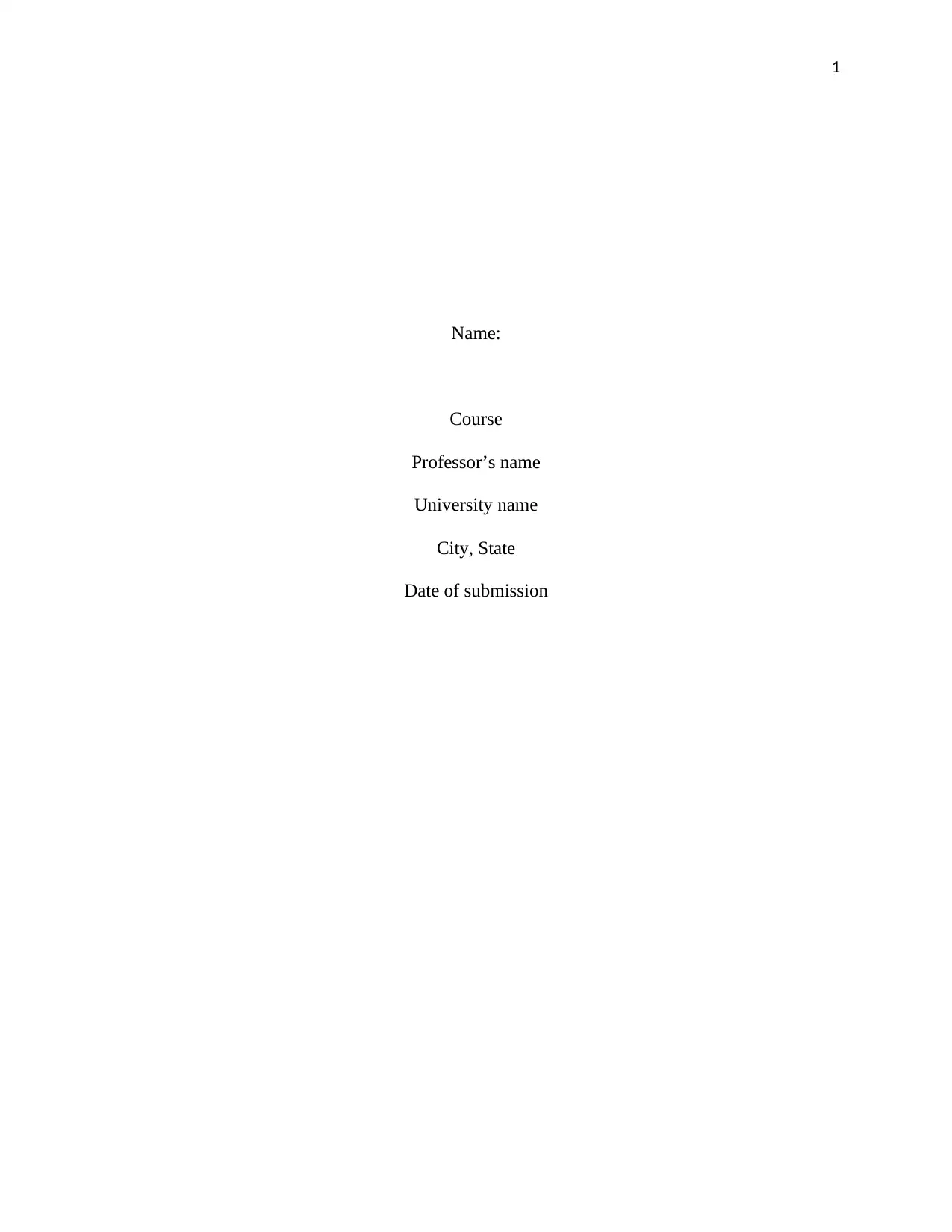
1
Name:
Course
Professor’s name
University name
City, State
Date of submission
Name:
Course
Professor’s name
University name
City, State
Date of submission
Paraphrase This Document
Need a fresh take? Get an instant paraphrase of this document with our AI Paraphraser
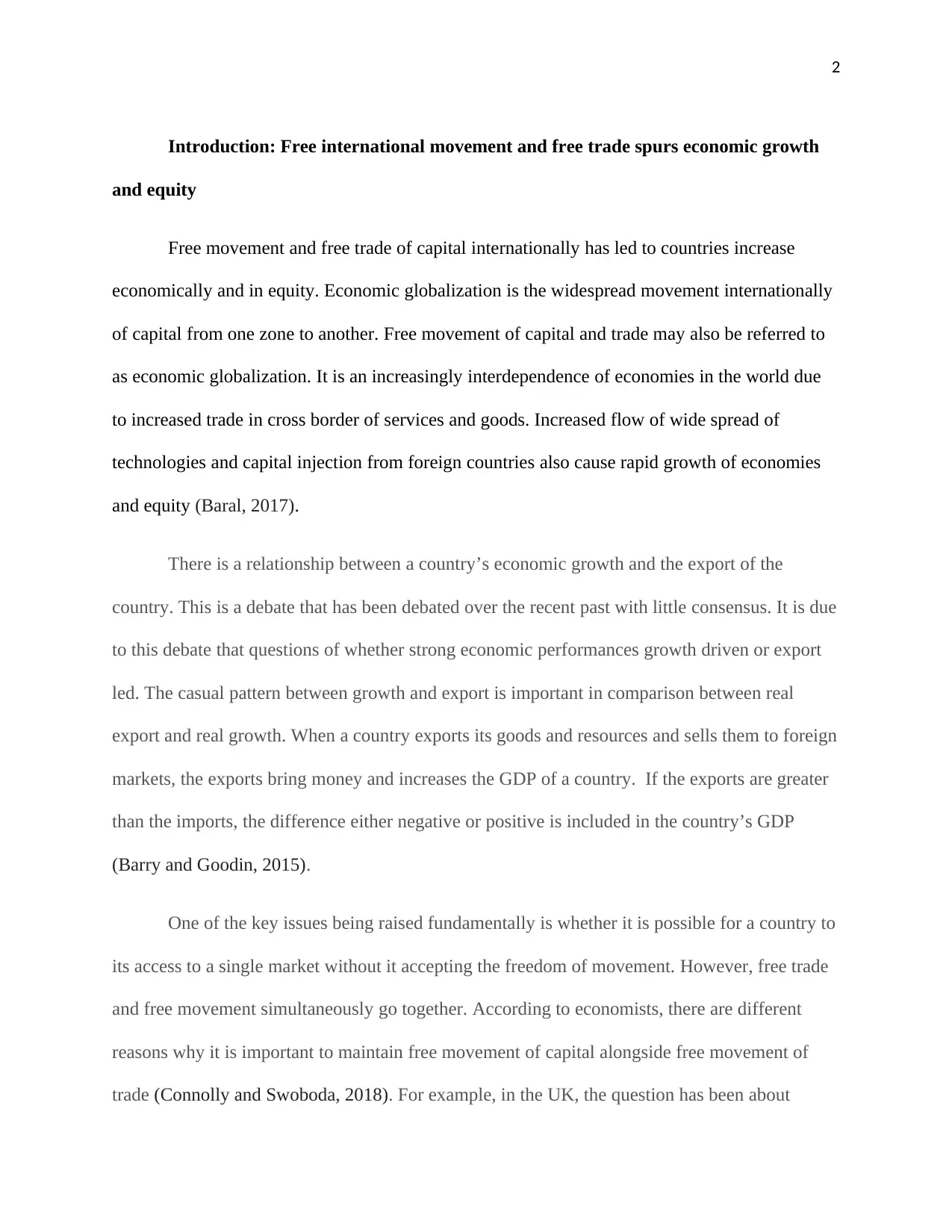
2
Introduction: Free international movement and free trade spurs economic growth
and equity
Free movement and free trade of capital internationally has led to countries increase
economically and in equity. Economic globalization is the widespread movement internationally
of capital from one zone to another. Free movement of capital and trade may also be referred to
as economic globalization. It is an increasingly interdependence of economies in the world due
to increased trade in cross border of services and goods. Increased flow of wide spread of
technologies and capital injection from foreign countries also cause rapid growth of economies
and equity (Baral, 2017).
There is a relationship between a country’s economic growth and the export of the
country. This is a debate that has been debated over the recent past with little consensus. It is due
to this debate that questions of whether strong economic performances growth driven or export
led. The casual pattern between growth and export is important in comparison between real
export and real growth. When a country exports its goods and resources and sells them to foreign
markets, the exports bring money and increases the GDP of a country. If the exports are greater
than the imports, the difference either negative or positive is included in the country’s GDP
(Barry and Goodin, 2015).
One of the key issues being raised fundamentally is whether it is possible for a country to
its access to a single market without it accepting the freedom of movement. However, free trade
and free movement simultaneously go together. According to economists, there are different
reasons why it is important to maintain free movement of capital alongside free movement of
trade (Connolly and Swoboda, 2018). For example, in the UK, the question has been about
Introduction: Free international movement and free trade spurs economic growth
and equity
Free movement and free trade of capital internationally has led to countries increase
economically and in equity. Economic globalization is the widespread movement internationally
of capital from one zone to another. Free movement of capital and trade may also be referred to
as economic globalization. It is an increasingly interdependence of economies in the world due
to increased trade in cross border of services and goods. Increased flow of wide spread of
technologies and capital injection from foreign countries also cause rapid growth of economies
and equity (Baral, 2017).
There is a relationship between a country’s economic growth and the export of the
country. This is a debate that has been debated over the recent past with little consensus. It is due
to this debate that questions of whether strong economic performances growth driven or export
led. The casual pattern between growth and export is important in comparison between real
export and real growth. When a country exports its goods and resources and sells them to foreign
markets, the exports bring money and increases the GDP of a country. If the exports are greater
than the imports, the difference either negative or positive is included in the country’s GDP
(Barry and Goodin, 2015).
One of the key issues being raised fundamentally is whether it is possible for a country to
its access to a single market without it accepting the freedom of movement. However, free trade
and free movement simultaneously go together. According to economists, there are different
reasons why it is important to maintain free movement of capital alongside free movement of
trade (Connolly and Swoboda, 2018). For example, in the UK, the question has been about
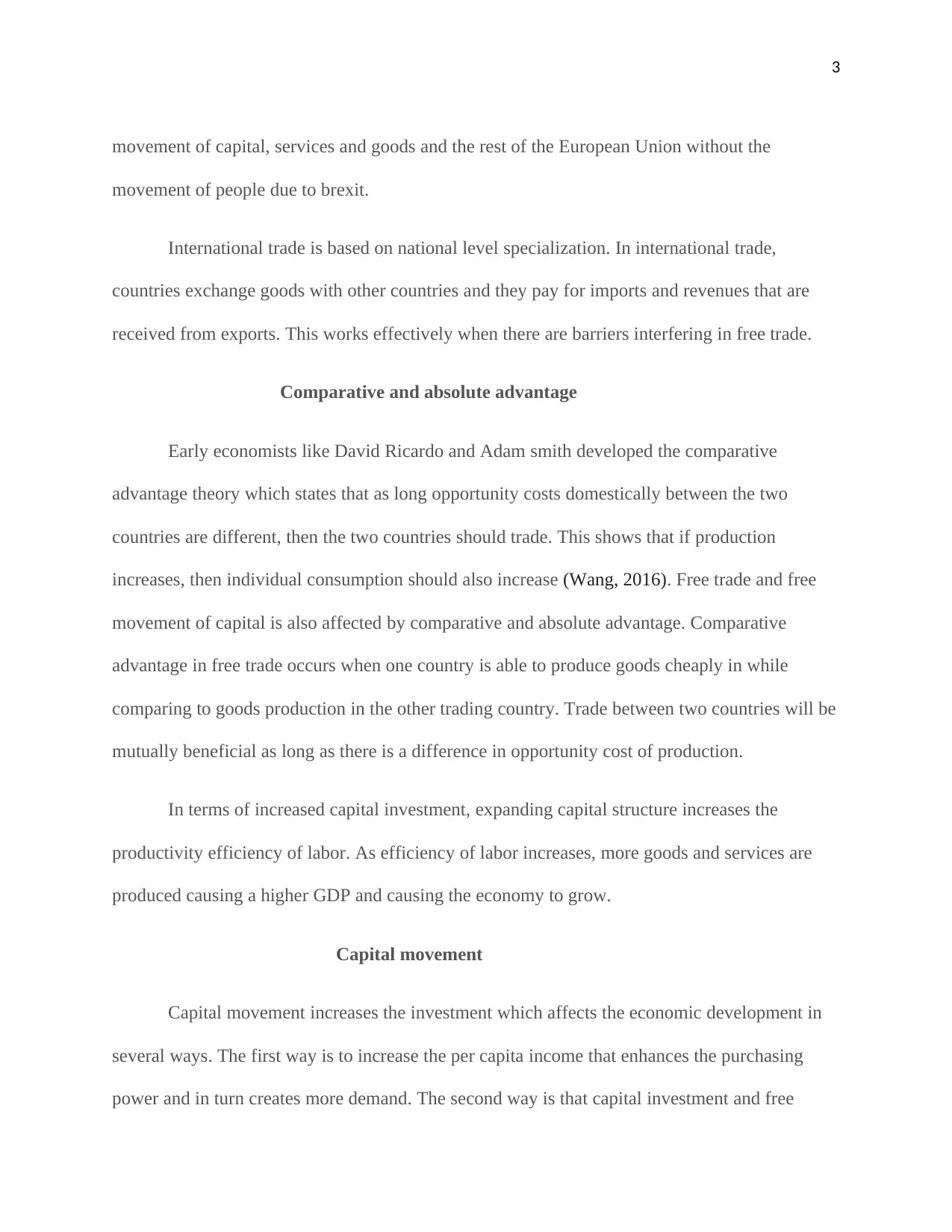
3
movement of capital, services and goods and the rest of the European Union without the
movement of people due to brexit.
International trade is based on national level specialization. In international trade,
countries exchange goods with other countries and they pay for imports and revenues that are
received from exports. This works effectively when there are barriers interfering in free trade.
Comparative and absolute advantage
Early economists like David Ricardo and Adam smith developed the comparative
advantage theory which states that as long opportunity costs domestically between the two
countries are different, then the two countries should trade. This shows that if production
increases, then individual consumption should also increase (Wang, 2016). Free trade and free
movement of capital is also affected by comparative and absolute advantage. Comparative
advantage in free trade occurs when one country is able to produce goods cheaply in while
comparing to goods production in the other trading country. Trade between two countries will be
mutually beneficial as long as there is a difference in opportunity cost of production.
In terms of increased capital investment, expanding capital structure increases the
productivity efficiency of labor. As efficiency of labor increases, more goods and services are
produced causing a higher GDP and causing the economy to grow.
Capital movement
Capital movement increases the investment which affects the economic development in
several ways. The first way is to increase the per capita income that enhances the purchasing
power and in turn creates more demand. The second way is that capital investment and free
movement of capital, services and goods and the rest of the European Union without the
movement of people due to brexit.
International trade is based on national level specialization. In international trade,
countries exchange goods with other countries and they pay for imports and revenues that are
received from exports. This works effectively when there are barriers interfering in free trade.
Comparative and absolute advantage
Early economists like David Ricardo and Adam smith developed the comparative
advantage theory which states that as long opportunity costs domestically between the two
countries are different, then the two countries should trade. This shows that if production
increases, then individual consumption should also increase (Wang, 2016). Free trade and free
movement of capital is also affected by comparative and absolute advantage. Comparative
advantage in free trade occurs when one country is able to produce goods cheaply in while
comparing to goods production in the other trading country. Trade between two countries will be
mutually beneficial as long as there is a difference in opportunity cost of production.
In terms of increased capital investment, expanding capital structure increases the
productivity efficiency of labor. As efficiency of labor increases, more goods and services are
produced causing a higher GDP and causing the economy to grow.
Capital movement
Capital movement increases the investment which affects the economic development in
several ways. The first way is to increase the per capita income that enhances the purchasing
power and in turn creates more demand. The second way is that capital investment and free
⊘ This is a preview!⊘
Do you want full access?
Subscribe today to unlock all pages.

Trusted by 1+ million students worldwide
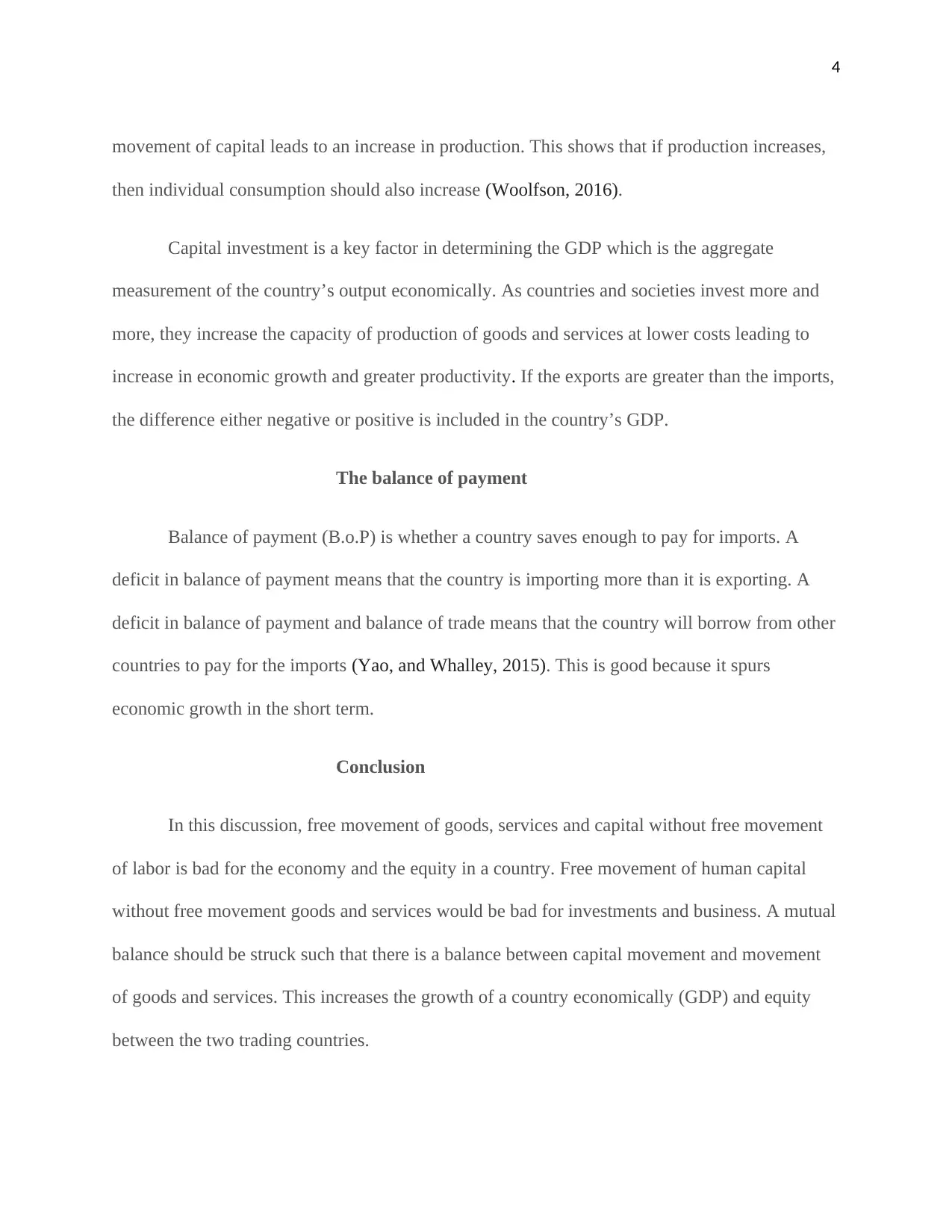
4
movement of capital leads to an increase in production. This shows that if production increases,
then individual consumption should also increase (Woolfson, 2016).
Capital investment is a key factor in determining the GDP which is the aggregate
measurement of the country’s output economically. As countries and societies invest more and
more, they increase the capacity of production of goods and services at lower costs leading to
increase in economic growth and greater productivity. If the exports are greater than the imports,
the difference either negative or positive is included in the country’s GDP.
The balance of payment
Balance of payment (B.o.P) is whether a country saves enough to pay for imports. A
deficit in balance of payment means that the country is importing more than it is exporting. A
deficit in balance of payment and balance of trade means that the country will borrow from other
countries to pay for the imports (Yao, and Whalley, 2015). This is good because it spurs
economic growth in the short term.
Conclusion
In this discussion, free movement of goods, services and capital without free movement
of labor is bad for the economy and the equity in a country. Free movement of human capital
without free movement goods and services would be bad for investments and business. A mutual
balance should be struck such that there is a balance between capital movement and movement
of goods and services. This increases the growth of a country economically (GDP) and equity
between the two trading countries.
movement of capital leads to an increase in production. This shows that if production increases,
then individual consumption should also increase (Woolfson, 2016).
Capital investment is a key factor in determining the GDP which is the aggregate
measurement of the country’s output economically. As countries and societies invest more and
more, they increase the capacity of production of goods and services at lower costs leading to
increase in economic growth and greater productivity. If the exports are greater than the imports,
the difference either negative or positive is included in the country’s GDP.
The balance of payment
Balance of payment (B.o.P) is whether a country saves enough to pay for imports. A
deficit in balance of payment means that the country is importing more than it is exporting. A
deficit in balance of payment and balance of trade means that the country will borrow from other
countries to pay for the imports (Yao, and Whalley, 2015). This is good because it spurs
economic growth in the short term.
Conclusion
In this discussion, free movement of goods, services and capital without free movement
of labor is bad for the economy and the equity in a country. Free movement of human capital
without free movement goods and services would be bad for investments and business. A mutual
balance should be struck such that there is a balance between capital movement and movement
of goods and services. This increases the growth of a country economically (GDP) and equity
between the two trading countries.
Paraphrase This Document
Need a fresh take? Get an instant paraphrase of this document with our AI Paraphraser
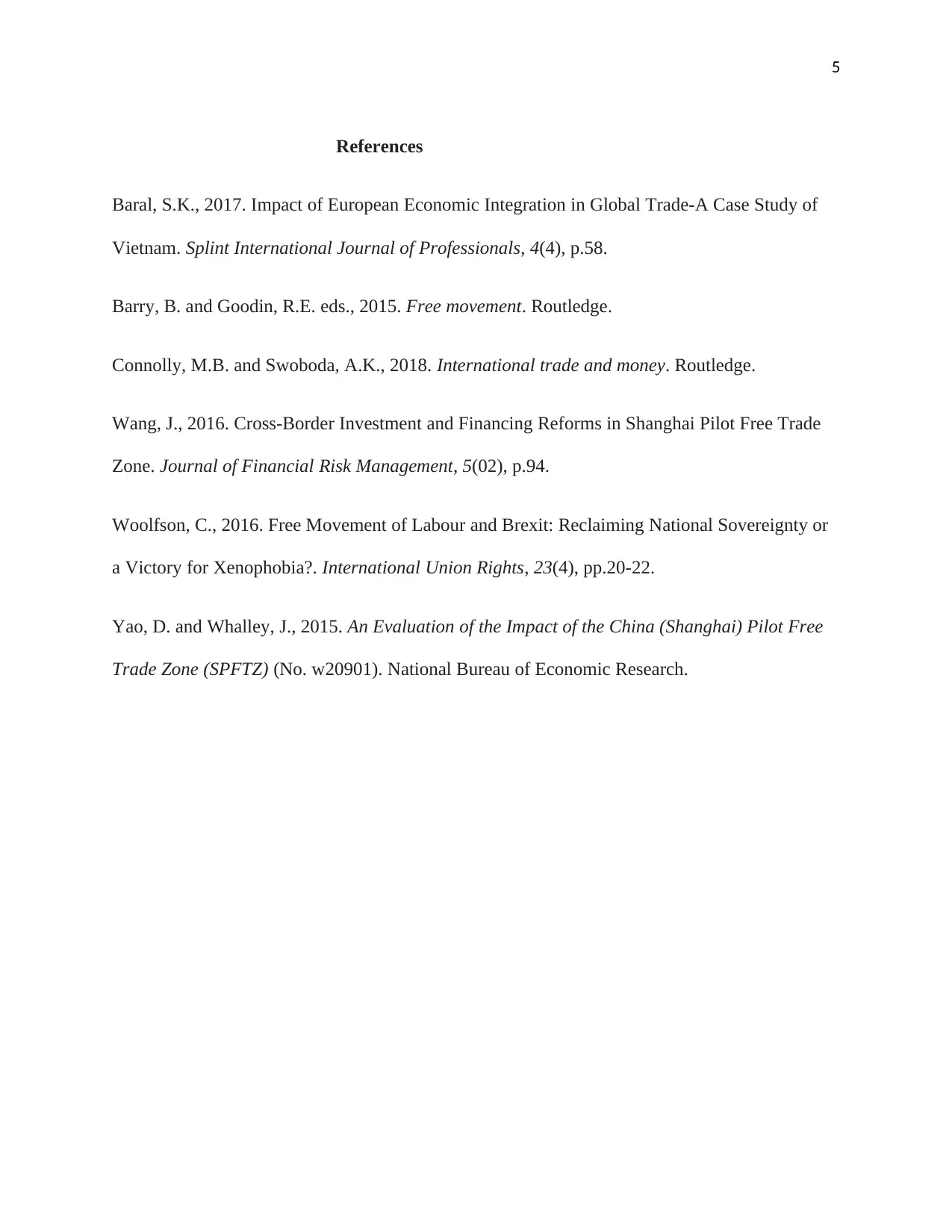
5
References
Baral, S.K., 2017. Impact of European Economic Integration in Global Trade-A Case Study of
Vietnam. Splint International Journal of Professionals, 4(4), p.58.
Barry, B. and Goodin, R.E. eds., 2015. Free movement. Routledge.
Connolly, M.B. and Swoboda, A.K., 2018. International trade and money. Routledge.
Wang, J., 2016. Cross-Border Investment and Financing Reforms in Shanghai Pilot Free Trade
Zone. Journal of Financial Risk Management, 5(02), p.94.
Woolfson, C., 2016. Free Movement of Labour and Brexit: Reclaiming National Sovereignty or
a Victory for Xenophobia?. International Union Rights, 23(4), pp.20-22.
Yao, D. and Whalley, J., 2015. An Evaluation of the Impact of the China (Shanghai) Pilot Free
Trade Zone (SPFTZ) (No. w20901). National Bureau of Economic Research.
References
Baral, S.K., 2017. Impact of European Economic Integration in Global Trade-A Case Study of
Vietnam. Splint International Journal of Professionals, 4(4), p.58.
Barry, B. and Goodin, R.E. eds., 2015. Free movement. Routledge.
Connolly, M.B. and Swoboda, A.K., 2018. International trade and money. Routledge.
Wang, J., 2016. Cross-Border Investment and Financing Reforms in Shanghai Pilot Free Trade
Zone. Journal of Financial Risk Management, 5(02), p.94.
Woolfson, C., 2016. Free Movement of Labour and Brexit: Reclaiming National Sovereignty or
a Victory for Xenophobia?. International Union Rights, 23(4), pp.20-22.
Yao, D. and Whalley, J., 2015. An Evaluation of the Impact of the China (Shanghai) Pilot Free
Trade Zone (SPFTZ) (No. w20901). National Bureau of Economic Research.
1 out of 5
Related Documents
Your All-in-One AI-Powered Toolkit for Academic Success.
+13062052269
info@desklib.com
Available 24*7 on WhatsApp / Email
![[object Object]](/_next/static/media/star-bottom.7253800d.svg)
Unlock your academic potential
Copyright © 2020–2025 A2Z Services. All Rights Reserved. Developed and managed by ZUCOL.





